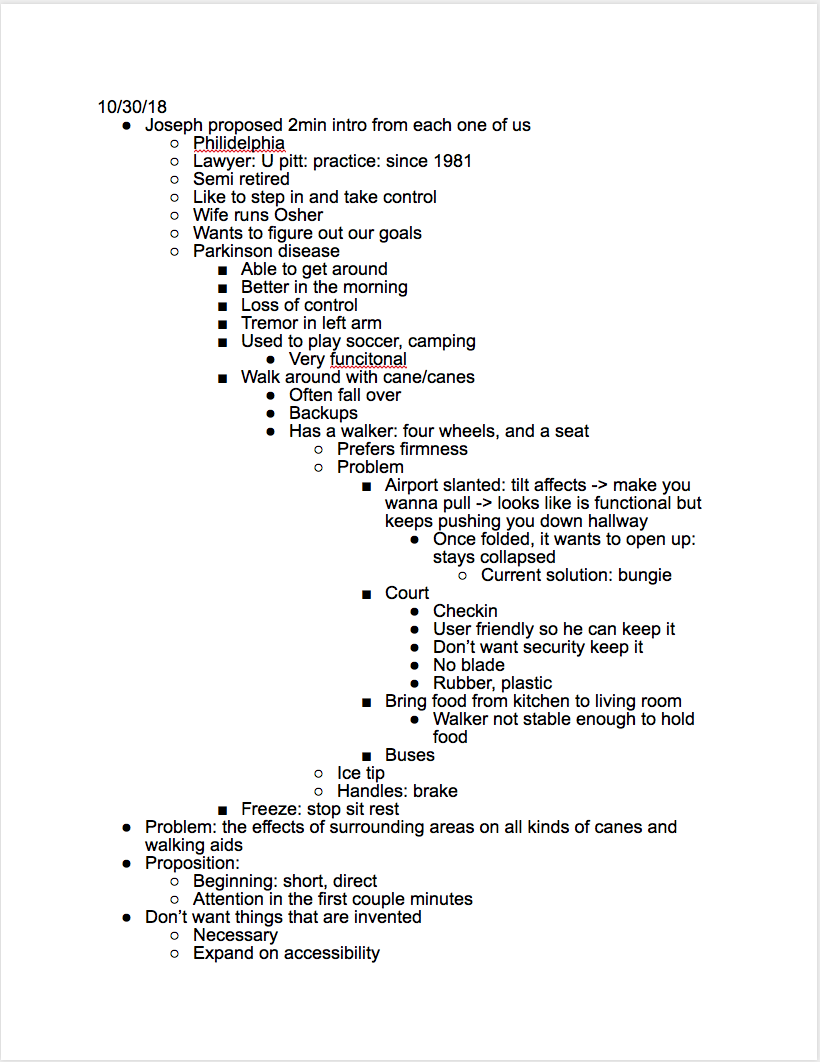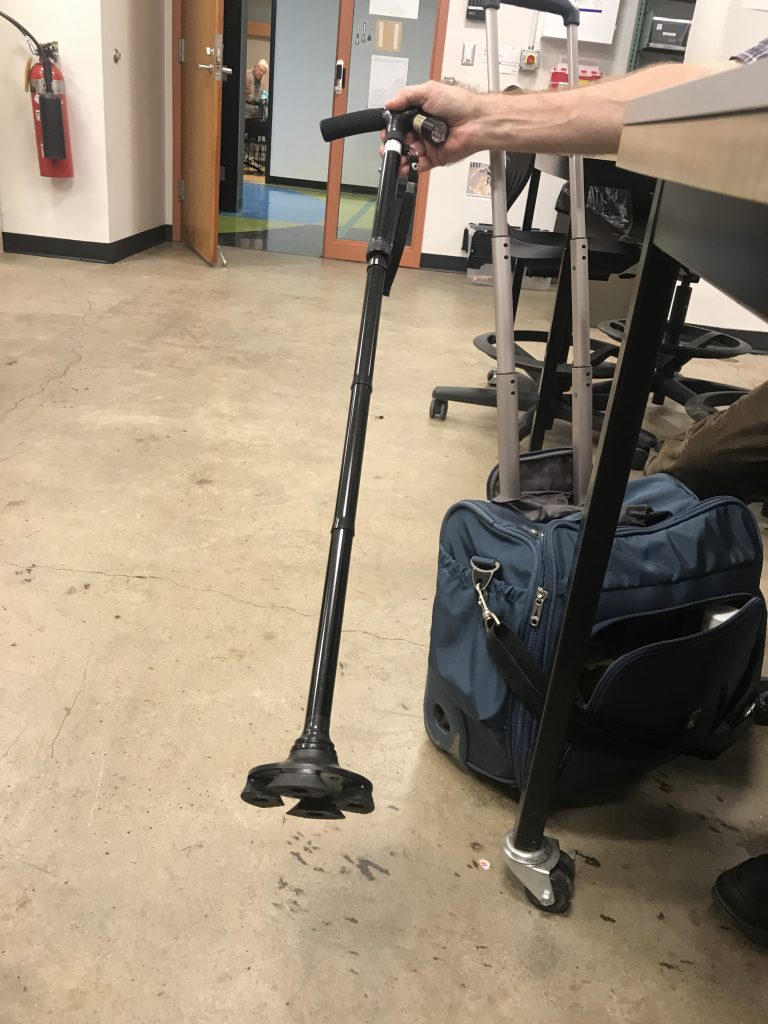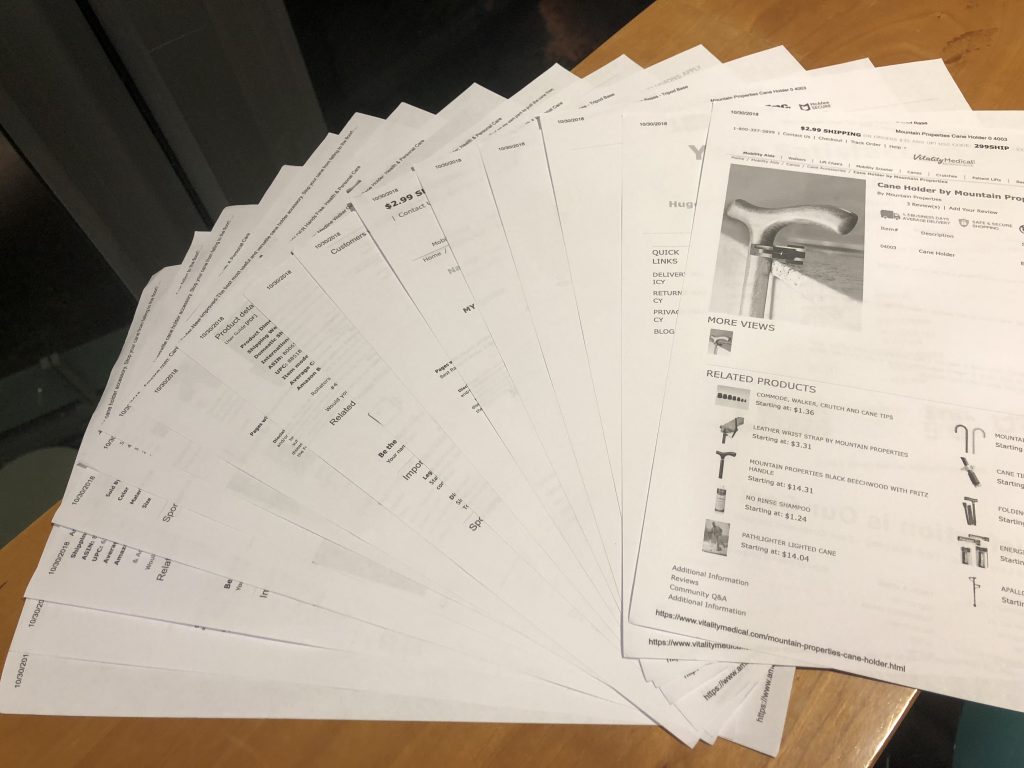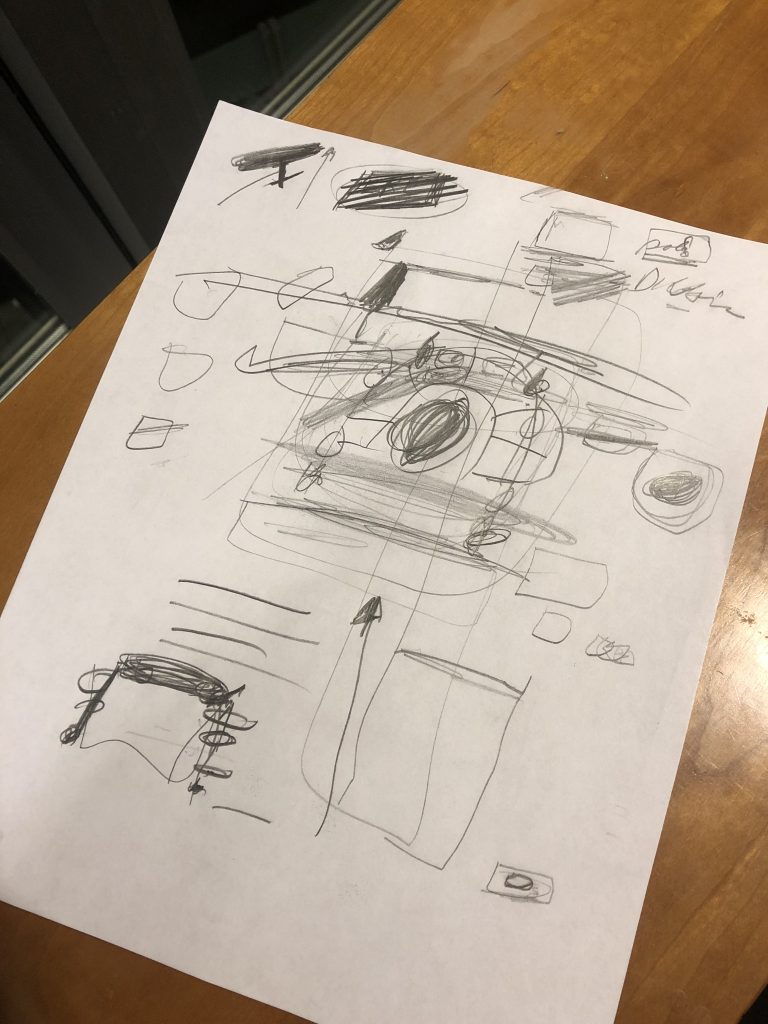Brief introduction
Team: Joey Santillo, Linda Xia, Catherine Yu
TEAM JOSEPH
We are a group of students at Carnegie Mellon enrolled in Introduction to Physical Computing. For our final project, our team is tasked with prototyping a useful implement for an older person. Using the skills that we’ve learned throughout the semester, we will design a technological prototype that will serve a particular older person’s need.
On Tuesday, October 30th, we met with Joseph, our older friend, in the Hunt Library basement to chat about the project, learn about his everyday life, and identify different needs that he has that can be fulfilled with a technological solution.
Meeting agenda
Introduction
- Go around, introduce our names, majors, and where we’re from.
- We’re interested in learning about any pain points or issues that you have while going through your daily life.
- Clarify our project goals.
- As a group, we’re interested in designing a useful implement that would help you in your daily life.
- We will engage in an iterative design process, including gathering formative feedback around the midpoint of the process, and using your feedback to iterate and design an improved prototype.
- The entire process takes six weeks, from this meeting to the end of the semester, with the final deliverable being a reasonably high-fidelity final product
- We will be thoroughly documenting our process, taking pictures & notes, and collecting other useful information.
- We are capable of building sophisticated devices; we had two other large projects to develop expertise with the Arduino software and hardware.
- Timeline
- We plan to meet with you at least 2 more times in person.
Interview questions
- What kind of hobbies do you have?
- Do you have any difficulties with these hobbies?
- What is a device that could make this hobby easier?
- Can you tell me the last time you ….
- Felt annoyed at a particular process throughout your day?
- What is something that you have enjoyed doing, but has now become harder to do with age?
(Optional) Crafting
- Can go into the classroom to get materials.
- Mock up a quick, low-fidelity “solution”.
Meeting summary & major takeaways

Notes taken during meeting

Notes took during meeting

The cane cannot stand by itself and it causes interferences and inconveniences when putting on the floor or table. Multiple times during our conversation with Joseph, the cane slid against the table and started to fall, with Joseph automatically catching it before it did.
After brief introductions from our team members, Joseph introduced himself. At 67 years old, Joseph is a semi-retired, part-time attorney who was born in Philadelphia. As a patient of Parkinson’s disease, Joseph uses different walking aids, such as canes and walkers, in order to supplement his mobility. While is he able to independently get around and take the bus by himself, he has tremor in left arm and occasionally has moments where he “freezes”, or where he is temporarily unable to move.

Another cane he carries around. This cane has four pressure points where it touches the ground, giving it the benefit of being able to stand up by itself, but has the drawback of being unstable on slanted surfaces. Additionally, Joseph noted that he preferred the firmness of a single pressure point, and rocks and ground debris often got stuck between the four pressure points of this cane.
During his younger years, Joseph was very active; he enjoyed camping and playing soccer. Now, he identifies that “being functional” is a major problem in his life and summarizes it as “the effects of surrounding areas on all kinds of canes and walking aids”. He described multiple scenarios where his functionality is limited due to his condition. When he goes to the airport, the slanted path of the jet bridge “looks functional but pushes you down the hallway.” It then becomes difficult to control the speed of his movement when going down slanted surfaces. At home, Joseph brings food from the kitchen to the living room, but the walker he uses is not stable enough to hold food. Additionally, when doing housework in his garage, he often forgets where he left his cane. During our first meeting, Joseph also brought some online research he did on walking aids, which helped us better understand the different types of canes and walkers on the market currently, and better imagine what possible custom features we can integrate into the product that would help Joseph increase his mobility.

Prior to our meeting, Joseph printed out different webpages of canes and walkers that are sold online, and spent time to describe each of their features and how it can aid with everyday mobility for Parkinson’s patients.

Joseph’s sketch of condition, symptom, limitation.
At the end of the meeting, Joseph suggested us to research Parkinson’s disease — to look into the conditions, symptoms, and limitations, and attack the problem by “meeting conditions and symptoms under limitation”.

Sketches Joseph made to describe uses and flaws of his walker
Thoughts & Discussion
While we couldn’t research Joseph over the weekend by email, we were able to call him on short notice that following Monday and schedule a quick meeting that same day. We really appreciate Joseph moving his schedule around and taking the time to meet us on campus. Due to time constraints, we were unable to meet him in his home; we are hoping in a future meeting, we will be able to meet him in his home, see the many different types of canes and walkers that he has, how he uses them with his usual tasks at home, and develop a better understanding of his current solutions and living environment.
The meeting did not quite follow our agenda. Joseph had thoroughly thought about this project and did his research prior to the meeting. He had already prepared several suggestions on how to improve his walking aids, and let us know which features he liked the most out of all of his canes and walkers. It was incredibly helpful that he had brainstormed possible solutions already, and we discussed them in depth during the meeting. The conservation was very fluid, informative, and easy, because he answered all of our questions before we asked them, and he asked us some questions for clarification for this project. However, many of the problems he identified involved mechanical solutions that did not fit the technological scope of this project. Perhaps we should have emphasized earlier on that our class focuses on creating interactive objects with embedded behaviors. We think that we could have done better by directing the conversation to focus more on understanding his current mobility problems (rather than solutions from the get-go) which could have given us the flexibility to brainstorm more openly together, and additionally find design opportunities in the physical computing domain.

Leave a Reply
You must be logged in to post a comment.